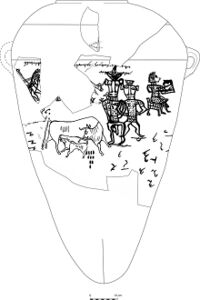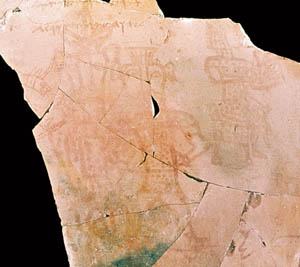Category:Monotheism, Origins (subject)
Monotheism, Origins of (subject)
The Ancient Israelite Religion before the Babylonian Exile was a variant of the polytheistic Canaanite religion. Between the 13th century BCE and the Babylonian Exile in the 6th century BCE, polytheism was normal throughout Israel; it was only after the exile that worship of YHWH alone became established.
Overview
The Israelites were originally Canaanites. They emerged into the historical record in the last decades of the 13th century BCE, at the very end of the Late Bronze Age.
El, "the kind, the compassionate", "the creator of creatures", was the chief of the Canaanite gods, and he, not YHWH, was the original "God of Israel"—the word "Israel" is based on the name El rather than YHWH. He lived in a tent on a mountain from whose base originated all the fresh waters of the world, with the goddess Asherah as his consort. This pair made up the top tier of the Canaanite pantheon; the second tier was made up of their children, the "seventy sons of Athirat" (a variant of the name Asherah).
YHWH was originally a minor deity, a "divine warrior from the southern region associated with Seir, Edom, Paran and Teman". In the earliest literature such as the Song of the Sea (Exodus 15:1–18, celebrating YHWH's victory over Egypt at the exodus), Yahweh is a warrior for his people, a storm-god typical of ancient Near Eastern myths, marching out from a region to the south or south-east of Israel with the heavenly host of stars and planets that make up his army. In Deut 32:8-9, YHWH (like his rival Baals) was seen as one of the "sons" of El Elyom, the supreme God of the Canaanite pantheon.
In both Judah and Samaria, YHWH was worshiped along with other gods in many sanctuaries (or "high places"), such as Bethel, Dan and others. The so-called "First Temple" of Jerusalem originally was simply one among the many temples dedicated to YHWH (and other gods). Despite the presence of henotheistic trends (led by the prophets of YHWH), the Israelite population in two kingdoms was polytheistic. Their religious practices did not differ from those of the other peoples of the region (including Child Sacrifice).
It was common in the ancient world to believe that gods married and bore children. As the other Canaanite gods, YHWH also was worshiped with a female counterpart, Asherah. Wisdom was another goddess, at the center of the fertility cults.
Deuteronomy 32:8-9
When the Most High (El Elyon) apportioned the nations,
when he divided humankind,
he fixed the boundaries of the peoples
according to the number of the gods; (a)
9 the Lord’s own portion was his people,
Jacob his allotted share.
< (a) The Masoretic tradition reads "according to the number of the sons of Israel" (bene israel). Howerer this was not the original text: In Qumran we read "according to the numbers of the sons of God" (bene el; or, bene elohim). The ancient Greek version (LXX) translates huion theou ("sons of God") or angelon theou ("angels of God"). In the Bible the sons of God are divine beings who belong to the heavenly court. They are the ancient gods turned into "angels". See Genesis 6:2; 1 Kings 22:19; Job 1:6; Psalms 29:1; 82. It is to the members of heavenly court that God said: "let us make man in our own image" (Gen 1:26)>
Inscription on a Pithos from Kuntillet ‘Ajrud (8th cent. BCE)
Located in the Sinai desert about 10 miles west of the ancient Gaza Road (Darb Ghazza, in Arabic) as it passes through Bedouin territory separating the Negev from Egypt, Kuntillet ‘Ajrud is remote and isolated from any other settlement. In 1975, Tel Aviv University archaeologist Ze’ev Meshel with some volunteers and a few colleagues as staff, decided to excavate at the site.
The finds from Kuntillet ‘Ajrud were fantastic. The zingers were two large pithoi, or storage jars, that weighed about 30 pounds each. The now-reconstructed pithoi are painted with deities, humans, animals and symbols, and feature a number of inscriptions, including three that refer to YHWH and his wife Asherah.
“I bless you by YHWH and his Asherah” is written across the top of this eighth-century B.C. drawing on a ceramic pithos, or storage jar, from Kuntillet ‘Ajrud in the eastern Sinai. Scholars have theorized that these figures resembling the Egyptian god Bes (who is the one depicted on the left) are in fact a drawing of YHWH and his consort. Two other similar inscriptions have been found in the site of this ancient sanctuary: "YHWH of Teman and his Asherah", and "Blessed be Uriyahu by YHWH for from his enemies by his (YHWH's) Asherah he (YHWH) has saved him ... "
Worship of YHWH alone
The worship of YHWH alone began at the earliest in the 8th century BCE; even then it remained the concern of a small party before gaining ascendancy in the Babylonian exile and early post-exilic period. The early supporters of this faction are widely regarded as being henotheist and monolatrists rather than true monotheists; they did not believe YHWH was the only god in existence, but instead believed he was the only god the people of Israel should worship. THis was the sense of the Reforms of Hezekiah and Josiah, aimed to stengthen the religious and politica independence of the Kingdom of Judah. Finally, in the national crisis of the exile, the followers of YHWH went a step further and outright denied that the other deities aside from YHWH even existed, thus marking the transition from monolatrism to true monotheism.
Outside Judaism, YHWH continued to be frequently invoked in Graeco-Roman magical texts from the 2nd century BCE to the 5th century CE under the names Iao, Adonai, Sabaoth, and Eloai.
- See Monotheism
Media in category "Monotheism, Origins (subject)"
The following 10 files are in this category, out of 10 total.
- 1864 Vuilleumier.jpg 667 × 1,000; 24 KB
- 1990 Moor.jpg 657 × 1,000; 89 KB
- 1990 Smith.jpg 338 × 500; 40 KB
- 1992 Frymer-Kensky.jpg 324 × 499; 30 KB
- 1996-E * Edelman.jpg 275 × 400; 22 KB
- 1997 Gnuse.jpg 1,001 × 1,500; 73 KB
- 2001 Smith.jpg 333 × 499; 21 KB
- 2003 Lemaine.jpg 343 × 499; 12 KB
- 2004 Cook.jpg 907 × 1,360; 90 KB
- 2014 Romer.jpg 329 × 499; 8 KB











